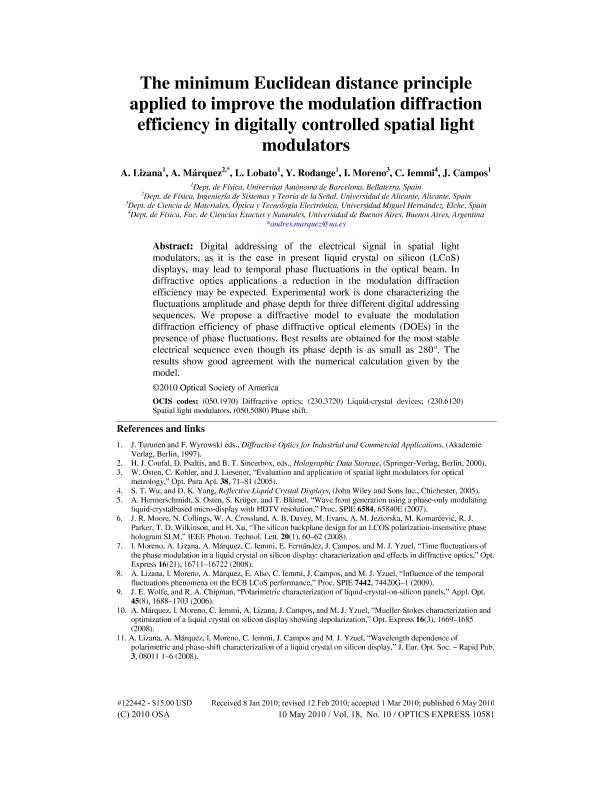Mostrar el registro sencillo del ítem
dc.contributor.author
Lizana, Ángel

dc.contributor.author
Márquez, A.
dc.contributor.author
Lobato, L.
dc.contributor.author
Rodange, Y.
dc.contributor.author
Moreno, I.
dc.contributor.author
Iemmi, Claudio Cesar

dc.contributor.author
Campos, Juan

dc.date.available
2017-05-15T21:09:56Z
dc.date.issued
2010
dc.identifier.citation
Lizana, Ángel; Márquez, A.; Lobato, L.; Rodange, Y.; Moreno, I.; et al.; The minimum Euclidean distance principle applied to improve the modulation diffraction efficiency in digitally controlled spatial light modulators; Optical Society Of America; Optics Express; 18; 10; 2010; 10581-10593
dc.identifier.issn
1094-4087
dc.identifier.uri
http://hdl.handle.net/11336/16513
dc.description.abstract
Digital addressing of the electrical signal in spatial light modulators, as it is the case in present liquid crystal on silicon (LCoS) displays, may lead to temporal phase fluctuations in the optical beam. In diffractive optics applications a reduction in the modulation diffraction efficiency may be expected. Experimental work is done characterizing the fluctuations amplitude and phase depth for three different digital addressing sequences. We propose a diffractive model to evaluate the modulation diffraction efficiency of phase diffractive optical elements (DOEs) in the presence of phase fluctuations. Best results are obtained for the most stable electrical sequence even though its phase depth is as small as 280°. The results show good agreement with the numerical calculation given by the model.
dc.format
application/pdf
dc.language.iso
eng
dc.publisher
Optical Society Of America

dc.rights
info:eu-repo/semantics/openAccess
dc.rights.uri
https://creativecommons.org/licenses/by/2.5/ar/
dc.subject
Diffractive Optics
dc.subject
Liquid Crystal Devices
dc.subject
Spatial Light Modulators
dc.subject
Phase Shift
dc.subject.classification
Óptica

dc.subject.classification
Ciencias Físicas

dc.subject.classification
CIENCIAS NATURALES Y EXACTAS

dc.title
The minimum Euclidean distance principle applied to improve the modulation diffraction efficiency in digitally controlled spatial light modulators
dc.type
info:eu-repo/semantics/article
dc.type
info:ar-repo/semantics/artículo
dc.type
info:eu-repo/semantics/publishedVersion
dc.date.updated
2017-05-11T20:56:53Z
dc.journal.volume
18
dc.journal.number
10
dc.journal.pagination
10581-10593
dc.journal.pais
Estados Unidos

dc.journal.ciudad
Washington DC
dc.description.fil
Fil: Lizana, Ángel. Universitat Autonoma de Barcelona; España
dc.description.fil
Fil: Márquez, A.. Universidad de Alicante; España
dc.description.fil
Fil: Lobato, L.. Universitat Autonoma de Barcelona; España
dc.description.fil
Fil: Rodange, Y.. Universitat Autonoma de Barcelona; España
dc.description.fil
Fil: Moreno, I.. Universidad de Miguel Hernandez; España
dc.description.fil
Fil: Iemmi, Claudio Cesar. Universidad de Buenos Aires. Facultad de Ciencias Exactas y Naturales. Departamento de Física; Argentina. Consejo Nacional de Investigaciones Científicas y Técnicas; Argentina
dc.description.fil
Fil: Campos, Juan. Universitat Autonoma de Barcelona; España
dc.journal.title
Optics Express

dc.relation.alternativeid
info:eu-repo/semantics/altIdentifier/url/http://dx.doi.org/10.1364/OE.18.010581
dc.relation.alternativeid
info:eu-repo/semantics/altIdentifier/url/https://www.osapublishing.org/oe/abstract.cfm?uri=oe-18-10-10581
Archivos asociados
